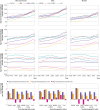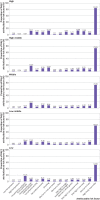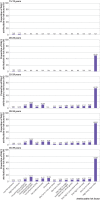Global burden of type 2 diabetes in adolescents and young adults, 1990-2019: systematic analysis of the Global Burden of Disease Study 2019
- PMID: 36740855
- PMCID: PMC9727920
- DOI: 10.1136/bmj-2022-072385
Global burden of type 2 diabetes in adolescents and young adults, 1990-2019: systematic analysis of the Global Burden of Disease Study 2019
Abstract
Objective: To estimate the global burden of type 2 diabetes in adolescents and young adults (aged 15-39 years) from 1990 to 2019.
Design: Systematic analysis.
Data source: Global Burden of Disease Study 2019. Participants aged 15-39 years from 204 countries and territories, 1990-2019.
Main outcomes measures: Age standardised incidence rate, age standardised disability adjusted life years (DALY) rate, and age standardised mortality rate for type 2 diabetes in people aged 15-39 years from 1990 to 2019, and proportional DALY attributable to different risk factors.
Results: From 1990 to 2019, significant increases in age standardised incidence rate and age standardised DALY rate were found for type 2 diabetes in adolescents and young adults globally (P<0.001). Age standardised incidence rate (per 100 000 population) increased from 117.22 (95% confidence interval 117.07 to 117.36) in 1990 to 183.36 (183.21 to 183.51) in 2019, and age standardised DALY rate (per 100 000 population) increased from 106.34 (106.20 to 106.48) in 1990 to 149.61 (149.47 to 149.75) in 2019. The age standardised mortality rate (per 100 000 population) was modestly increased from 0.74 (0.72 to 0.75) in 1990 to 0.77 (0.76 to 0.78) in 2019. When grouped by countries with different sociodemographic indexes, countries with a low-middle and middle sociodemographic index had the highest age standardised incidence rate and age standardised DALY rate in 2019, whereas countries with a low sociodemographic index had the lowest age standardised incidence rate but the highest age standardised mortality rate. Women generally had higher mortality and DALY rates than men at ages <30 years, but differences between the sexes were reversed in those aged >30 years except in countries with a low sociodemographic index. The main attributable risk factor for DALY for early onset type 2 diabetes was high body mass index in all regions by sociodemographic index. The proportional contribution of other risk factors varied across regions, however, with higher proportions of ambient particulate air pollution and smoking in countries with a high sociodemographic index and higher proportions of household air pollution from solid fuels and diet low in fruit in countries with a low sociodemographic index.
Conclusions: Early onset type 2 diabetes is a growing global health problem in adolescents and young adults, especially in countries with a low-middle and middle sociodemographic index. A greater disease burden in women aged <30 years was found. Specific measures are needed in countries with different levels of socioeconomic development because of the variable attributable risk factors for type 2 diabetes in adolescents and young adults.
© Author(s) (or their employer(s)) 2019. Re-use permitted under CC BY-NC. No commercial re-use. See rights and permissions. Published by BMJ.
Conflict of interest statement
Competing interests: All authors have completed the ICMJE uniform disclosure form at www.icmje.org/disclosure-of-interest/ and declare: support from the National Nature Science Foundation of China, Dr Wu Lien Teh Science Foundation of Harbin Medical University, and the Fundamental Research Funds for the Central Universities for the submitted work; no financial relationships with any organisations that might have an interest in the submitted work in the previous three years; no other relationships or activities that could appear to have influenced the submitted work.
Figures







References
-
- International Diabetes Federation. IDF Diabetes Atlas, 10th edn. Brussels, Belgium: 2021. https://www.diabetesatlas.org.
MeSH terms
LinkOut - more resources
Full Text Sources
Medical
